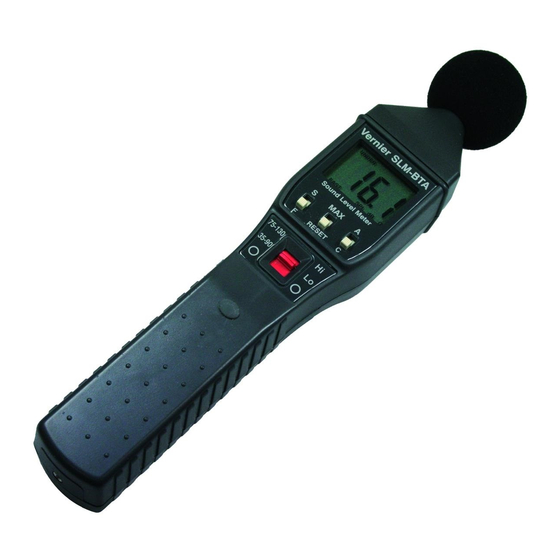
Advertisement
Sound Level Meter
(Order Code SLM-BTA)
The Sound Level Meter measures sound level in decibels. It
can be used for activities such as
environmental noise studies
sound level comparisons
investigating room acoustics
sound isolation modeling
sound propagation modeling
Inventory of Items Included with the Sound Level Meter
Check to be sure that each of these items is included in your Sound Level Meter
package:
Sound Level Meter
Wind screen (black foam cover for the sensing element)
4 AAA batteries (preinstalled in the meter)
Cable to connect the sensor to a data-collection interface (order code
CB-SLM)
NOTE: Vernier products are designed for educational use. Our products are not
designed nor recommended for any industrial, medical, or commercial process such
as life support, patient diagnosis, control of a manufacturing process, or industrial
testing of any kind.
Sound Level Meter Description
The sensing microphone on the Sound Level Meter is located at the end of the silver
barrel at the top of the meter. Below the LCD, you will find three switches labeled
S/F, MAX/RESET, A/C. Below these switches you will find the power/measurement
range switch. Further description of these switches follows. The battery
compartment is located on the back of the Sound Level Meter. A signal output
terminal is located on the bottom of the meter. The output of this terminal is sent to
data collection interface.
The LCD panel displays noise levels in dB. A low battery level indicator and an
upper/lower range indicator are also displayed.
The sensor comes with a foam windscreen. The windscreen helps reduce the
detection of false high signals caused by wind blowing across the microphone. It
also protects the microphone from dust and debris.
Panel Switches
Power/Measurement Range Switch–This slide switch, labeled "O/35–90/75–130,"
turns the sensor on and sets the measurement range. When set to the 35–90 range
(LO), the sensor is designed to measure sound levels in the range of 35 to 90 dB.
When the switch is set to the 75–130 range (HI), the sensor is designed to measure
sound levels in the range of 75 to 130 dB. A range warning will appear if the
measured sound is beyond the range of the current setting. If this warning appears
continuously, set the switch to the appropriate range.
Time Weighting–The S/F switch just below the LCD sets the time weighting. For
normal measurements set the switch to the slow setting "S." For fluctuating noise,
set the weighting to fast "F." In the classroom, you will probably set it to "S."
Maximum Level Hold–Setting the MAX/RESET button to MAX sets the sensor
meter to show the maximum, weighted sound level. In the classroom you will
probably set it to RESET, in which case the display will continually display the
sampled reading. Setting this switch to MAX does not affect the output signal sent to
the data-collection interface.
Frequency Weighting–The A/C switch is used to set the weighting scale. "A"
weighted setting is the sound level value that most closely matches that of the human
hearing range. It is the weighting scale most commonly used for Occupational Safety
and Health Administration (OSHA) and Department of Environmental Quality
(DEQ) regulatory measurements. The "C" weighted scale is useful for monitoring
sources such as engines, explosions and machinery. This setting would also be used
if you wish to use the Sound Level Meter to get the total unweighted sound level of
the noise source.
2
Advertisement
Table of Contents

Summary of Contents for Vernier SLM-BTA
-
Page 1: Sound Level Meter
CB-SLM) Power/Measurement Range Switch–This slide switch, labeled “O/35–90/75–130,” NOTE: Vernier products are designed for educational use. Our products are not turns the sensor on and sets the measurement range. When set to the 35–90 range designed nor recommended for any industrial, medical, or commercial process such (LO), the sensor is designed to measure sound levels in the range of 35 to 90 dB. -
Page 2: Specifications
EasyData App This calculator application for the TI-83 Plus and TI-84 Plus can 1. Slide the power switch to the appropriate range. be used with CBL 2™, LabPro, and Vernier EasyLink. We recommend version 2. Set the time weighting switch to “S.”... -
Page 3: Calibration Information
The following chart shows the sound level exposure rates set by the OSHA How the Sound Level Meter Works Occupational Noise Exposure Standard. In a work environment, for example, it is The Sound Level Meter uses an electric condenser microphone mounted on the end of acceptable to be exposed to 90 dB for eight hours as measured on the “A”... - Page 4 4. Determine how long it takes the sound level to fall by a specific dB level from the several sounds that have the same “C” weighted sound level. Now measure these same sounds with the “A” weighting. Compare the difference between the two peak level.
-
Page 5: Warranty
Example Sound Levels Sound Pressure Level Source (dBA) Large Rocket (nearby) 180 to 194 Jet Aircraft Shotgun Blast Propeller Aircraft Pneumatic Riveter, Threshold of Pain Rock Concert, Thunder Construction Noise Subway Train Heavy Truck Noisy Restaurant Busy Traffic, Normal Radio Normal Conversation, Dishwasher Quiet Office Library... - Page 6 www.vernier.com Rev 6/5/2012 Logger Pro, Logger Lite, Vernier LabQuest 2, Vernier LabQuest, Vernier LabQuest Mini, Vernier LabPro, Go! Link, Vernier EasyLink and other marks shown are our trademarks or registered trademarks in the United States. TI-Nspire, CBL 2, TI-GRAPH LINK, and TI Connect are trademarks of Texas Instruments.
















Need help?
Do you have a question about the SLM-BTA and is the answer not in the manual?
Questions and answers